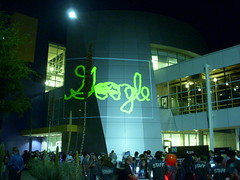Guerilla Marketing & Google Maps
My article on “Six Odd Tactics For Getting Ads Into Google Maps” posted today on Search Engine Land, and I believe many of my regular readers should find it moderately entertaining. The piece covers how some elements of guerrilla marketing have found their way into some Google Maps advertising patents, and also how some others have used creative means to get messages into Maps via “roofvertising”, “skywriting” and more.
Those familiar with Natural Search Blog may remember some of my similar past work here outlining laser graffiti ads on buildings, roofvertising, marriage proposals in Google Maps, “earth art” geoglyph ads, and sponsoring town names as an Ultimate Local SEO tactic.
It’s not surprising to see guerilla marketing tactics finding their way into Google Maps. Not only does Google itself seek to introduce disruptive technology innovations, but I expect that as Satellite and Aerial photos may get more frequently updated in such interfaces we’ll be bound to see a whole lot more efforts from people trying to get messages conveyed through the Maps interfaces.
The real question I’m left with, is if Google resells ad space on pictures of people’s rooftops and billboards, would they owe anything back to the original property owners?!?
Possible Related Posts
Posted by Chris of Silvery on 02/01/2010
Permalink | |  Print
| Trackback | Comments (0) | Comments RSS
Print
| Trackback | Comments (0) | Comments RSS
Filed under: Advertising, Futurism, Local Search, Maps, Marketing Billboards, Google-Maps, Guerilla-Advertising, Guerilla-Marketing, guerrilla advertising, guerrilla marketing, Map-Ads, Roofvertising, skywriting
Vint Cerf & The Architect in The Matrix
While attending and speaking at the recent SMX West conference in Santa Clara, I had the opportunity to photograph Vinton (“Vint”) Cerf, Google’s VP and Chief Internet Evangelist during his keynote interview conducted by Chris Sherman.
After returning, one of my friends saw my pics and remarked that Vint Cerf resembled the Architect character in the Matrix movies. It immediately struck me that he was right — so I knocked together a comparison pic:
Vint Cerf and the Architect in the Matrix share a number of feature similarities: similar age, dress, coloring, and facial hair. The biggest difference is that the Architect has a full head of hair while Vint is balding. (more…)
Possible Related Posts
Posted by Chris of Silvery on 02/20/2009
Permalink | |  Print
| Trackback | Comments (0) | Comments RSS
Print
| Trackback | Comments (0) | Comments RSS
Filed under: Conferences, Futurism, Google Architect, Chris-Sherman, Google, The Matrix, Vint Cerf
Google Launches New Virtual Reality: Lively
Google has finally launched the long-awaited Lively virtual reality service.
Will it be a SecondLife killer, as some have suggested? So far, no, since it doesn’t have one huge planet or room for interacting with everyone as SecondLife does.
But this is the first baby-step Google has taken into VR, and we can expect them to evolve it further, particularly if the service proves popular. I haven’t tried it out just yet, but the feature descriptions include adding VR rooms to webpages, pulling photos and vids into the VR environments, and tying it closely to Google Talk – Google’s chat service. (more…)
Possible Related Posts
Posted by Chris of Silvery on 07/08/2008
Permalink | |  Print
| Trackback | Comments Off on Google Launches New Virtual Reality: Lively | Comments RSS
Print
| Trackback | Comments Off on Google Launches New Virtual Reality: Lively | Comments RSS
Filed under: Futurism, Google, technology Google, Lively, virtual-reality, VR
Will Geolocation Become Ubiquitous?
Chris Messina at Citizen Agency has just blogged about how he believes that geolocation data will become ubiquitous for websites to use, and this sort of contextual information about users will form a new layer of information that will available to all internet applications.
I find myself a bit skeptical, just because geolocation data has been around for so long now, and I’ve heard people saying that it will revolutionize how information is presented to us for quite some time. This concept is nothing new, though if you look at it from the perspective that Messina has provided, it’s a fairly compelling-feeling twist as a sort of infrastructure given that could and should be incorporated in the planning and development of any given internet site — particularly social ones — at their very inception.
What isn’t plain is just how integral all the locative information could be, considering the issues of unknowable error rates involved in geolocation data (see the section on “The issue of error rates” in “Geolocation: Core To The Local Space And Key To Click-Fraud Detection“) and consumer interest group resistance to pinpointing of users’ locations based upon privacy concerns (just today there was an article on how groups are complaining to the FTC about the ease of geo-pinpointing of users of mobile devices). I wish he’d touched on those aspects in some way, although I do like the techno-evangelist spin he’s provided on location as a foundational aspect in site design.
Update: Susan Mernit, formerly of Yahoo!, also points out that security is a major concern for applications like dating sites, and that there’s consumer irritation involved with some contextual advertising.
Possible Related Posts
Posted by Chris of Silvery on 05/06/2008
Permalink | |  Print
| Trackback | Comments Off on Will Geolocation Become Ubiquitous? | Comments RSS
Print
| Trackback | Comments Off on Will Geolocation Become Ubiquitous? | Comments RSS
Filed under: Futurism, Local Search, Maps, Mobile Search geographic location, Geolocation, Local Search
Digital Graffiti Goes Mainstream: TIME Magazine Article
I noticed that TIME covered the laser graffiti artists of the Graffiti Research Lab this week. Nearly a year ago, I covered the phenomenon of guerrilla marketing via laser light images “drawn” on the sides of buildings at night.
Having this covered in a mainstream rag like TIME is probably nearly enough to make the concept jump the shark, and the novelty element and guerrilla marketing value could be virtually annihilated by familiarity.
I’m not really complaining so much as noting the effect — and noting that the promotion value of the medium could become rapidly eroded when it’s too common. The novelty and amusement factor could give way to annoyance if laser displayed images on buildings became frequent. When a methodology hits mainstream, it’s no longer “guerrilla”. 🙂
Possible Related Posts
Posted by Chris of Silvery on 04/15/2008
Permalink | |  Print
| Trackback | Comments Off on Digital Graffiti Goes Mainstream: TIME Magazine Article | Comments RSS
Print
| Trackback | Comments Off on Digital Graffiti Goes Mainstream: TIME Magazine Article | Comments RSS
Filed under: Futurism, Marketing, News graffiti, guerrilla advertising, guerrilla marketing
Laser-Projected Graffiti Ads on Buildings
In yet another example of cyberpunk fiction turned to reality, the Graffiti Research Lab has assembled a mobile unit that can project messages (“graffiti”) onto the sides of any large structure using a computer, laser projector, and a bicycle-powered generator. They recently tooled around Barcelona doing this up until the police apparently ticketed them and confiscated the projection equipment. Looking past the mischievous fun of the idea, could this be a new trendy advertising medium, about to take Madison Avenue by storm? Guerilla marketing companies seem to think so – click through for more of my thoughts on the matter.

The Batsignal, by Graffiti Research Lab, Barcelona, 2007
Possible Related Posts
Posted by Chris of Silvery on 06/11/2007
Permalink | |  Print
| Trackback | Comments Off on Laser-Projected Graffiti Ads on Buildings | Comments RSS
Print
| Trackback | Comments Off on Laser-Projected Graffiti Ads on Buildings | Comments RSS
Filed under: Advertising, Futurism, Marketing Ad-Campaigns, Ads, Advertising, cyberpunk, Futurism, Guerilla-Advertising, Guerilla-Marketing
Misguided Science Fiction Writers Advise U.S. on Homeland Security
 USA Today has reported in “Sci-fi writers join war on terror” that a small group of science fiction writers have been contacted by the U.S. government to advise on new and innovative ways that security could be improved. The group, called Sigma, was formed about 15 years ago by writer Arlan Andrews and was specifically intended to advise the government on advanced technology issues.
USA Today has reported in “Sci-fi writers join war on terror” that a small group of science fiction writers have been contacted by the U.S. government to advise on new and innovative ways that security could be improved. The group, called Sigma, was formed about 15 years ago by writer Arlan Andrews and was specifically intended to advise the government on advanced technology issues.
Their motto seems ominous in context of recent-history political trends and frighteningly nationalistic: “Science Fiction in the National Interest“. I think their involvement is a bit horrifying, misguided, and more than a bit egotistically self-grandiose. Read on for more details.
Possible Related Posts
Posted by Chris of Silvery on 05/31/2007
Permalink | |  Print
| Trackback | Comments Off on Misguided Science Fiction Writers Advise U.S. on Homeland Security | Comments RSS
Print
| Trackback | Comments Off on Misguided Science Fiction Writers Advise U.S. on Homeland Security | Comments RSS
Filed under: Futurism, News, Security, technology Arlan-Andrews, Eric-Kotani, Greg-Bear, Homeland-Security, Jerry-Pournelle, Larry-Niven, Sage-Walker, science-fiction, Sigma-Group
Could Nanotechnology Save Print Yellow Pages?
Technological evolution continues to change our everyday lives, and the speed of changes over the last two decades has caused an acceleration of impacts to traditional forms of business. Nowhere is this more evident than in the impact to usage of printed yellow pages directories. Once the mainstay for locating businesses, many consumers now treat the books as doorstops or fireplace kindling.
The Yellow Pages Association‘s annual report and other research indicates that consumer usage of print directories is on the decline while usage of online yellow pages and local search are increasing. The main divergence of opinion seems to be in how long it will be before print dies completely – ten years, fifty years, or a century? Simba research indicates that profits of core yellow pages are down while independent publishers are increasing at double-digit rates, indicating that advertisers continue to see value in print YP exposure. Even though the print biz still has lots of money and usage, those who have watched tech trends during the Information Age know that transitions of this sort can often reach a tipping point rapidly, perhaps rendering print YP irrelevant at the closer end of the timeline estimates.
In all the rush to sound the death-knell for print most folks are looking upon it as merely a dinosaur, soon to die as a result of the meteor-strike of internet search technology. But, could there be another future in store for print directories?
I’ve been watching developments in a number of converging lines of technology for a while now, and I foresee another potential fate for the print directories: nanotechnology. Read on and I’ll explain.
Possible Related Posts
Posted by Chris of Silvery on 03/20/2007
Permalink | |  Print
| Trackback | Comments Off on Could Nanotechnology Save Print Yellow Pages? | Comments RSS
Print
| Trackback | Comments Off on Could Nanotechnology Save Print Yellow Pages? | Comments RSS
Filed under: Futurism, Local Search, Online Directories, Research and Development, Yellow Pages iyp, nanotech, nanotechnology, Online Directories, Online-Yellow-Pages, print-yellow-pages, Yellow Pages
Google Developing Artificial Intelligence (AI) – Brave New World
Google’s Larry Page addressed the recent conference for the American Association for the Advancement of the Sciences, and in his presentation he revealed what many of us had suspected or already knew from some of our friends who are employees within the company: researchers in Google are working upon developing Artificial Intelligence (aka “AI”).
During the address, Page stated he thought that human brain algorithms actually weren’t all that complicated and could likely be approximated with sufficient computational power. He said, “We have some people at Google (who) are really trying to build artificial intelligence and to do it on a large scale. It’s not as far off as people think.” Well, one of the top scientists in the world disagrees, if he’s talking about approximating a human-like consciousness.
I’ve written previously about how stuff predicted in cyberpunk fiction is becoming reality, and how Google might be planning to develop intelligent ‘search pets’ which would directly integrate with the human brain in some fashion. What might Google use this for and how soon might they show it to the world? Read on…
Possible Related Posts
Posted by Chris of Silvery on 02/20/2007
Permalink | |  Print
| Trackback | Comments Off on Google Developing Artificial Intelligence (AI) – Brave New World | Comments RSS
Print
| Trackback | Comments Off on Google Developing Artificial Intelligence (AI) – Brave New World | Comments RSS
Filed under: Futurism, Google A-Scanner-Darkly, ai, artificial-intelligence, craig-silverstein, Futurism, Google, larry-page, science-fiction, Turing-tests
Brave New Future of SEO & SEM? Marketing thru Second Life
I came to hear about Second Life after reading about it in a blog by Greg Sterling, former editor and director of the Kelsey Group’s Interactive Local Media program. If you haven’t heard about it, read about it in this article. Second Life is basically a virtual reality (“VR”) platform (or, “world”, or “metaverse” if you will). People go in there, buy VR property or other objects, and interact with thousands of other participants.

“So what?” you might say. So, how does this differ from World of Warcraft, the Sims Online, or EverQuest?
First, there’s no goal to Second Life, per se — users just go into the thing, hang out, and interact with other users and the virtual environments. Second, users can own property in this world, and they can sell the property for real money in the real world! (Contrast with EverQuest, where they’ve actively worked to keep people from selling characters on eBay and such.) Finally, people have begun marketing through this new media — like gangbusters!

Copyright 2006, Linden Research, Inc. All Rights Reserved.
People like Anshe Chung are now making hundreds of thousands of dollars per year by designing and selling the SL virtual real estate. Others are offering services like architecture, event planning, selling artworks, scripting, and even financial or legal services. Some universities are now teaching within the space, too!
Possible Related Posts
Posted by Chris of Silvery on 10/24/2006
Permalink | |  Print
| Trackback | Comments Off on Brave New Future of SEO & SEM? Marketing thru Second Life | Comments RSS
Print
| Trackback | Comments Off on Brave New Future of SEO & SEM? Marketing thru Second Life | Comments RSS
Filed under: Futurism, Marketing, Search Engine Optimization, SEO online-marketing, Second-Life, SEM, SEO, virtual-reality, VR






